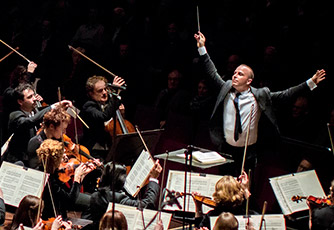What most interested me about seeing this performance was first of all the fact that this orchestra was from abroad, and that they would come all the way to Ann Arbor to perform. I have experienced orchestral and piano performances abroad as well and found that a lot of the charm of the event is in how it is presented and the social ritual attached to seeing a concert and how it varies in different parts of the world.
The first piece the Rotterdam Philharmonic performed was Maurice Ravel’s Suite from ‘Ma Mere l’Oye’ (Mother Goose). I had never encountered the piece previous to that night and I found myself surprised by the modernity of it. Maurice Ravel (1875-1937) was a French composer who was prominent during the early part of the twentieth century. Listening to this I was reminded of a time in elementary school when I was taught the different instruments and sections in the orchestra, and how each instrument was often used in plays or ballets to represent animals. I found this sentiment to be delightfully expressed in this piece by Ravel. He plays with the tempo and dynamic of the woodwinds such that they invoke images of fluttering birds or scurrying animals. This, in combination with the strings, brings a very full and vibrant environment to life and I think Ravel is very successful in this. As I have not seen this piece performed elsewhere, I find it hard to make comparisons or critiques of the Rotterdam Philharmonic Orchestra’s performance to others. I think that this piece was at least, in relation to the other pieces that the orchestra performed, the most successful and seemed like the most enjoyable to play.
Another aspect of this event that I enjoyed was the concert pianist, Hélène Grimaud. I studied the very basics of piano growing up, so watching her play and her fingers effortlessly and accurately play was quite enchanting for me personally. The way that the conductor and pianist take the center of the orchestra and both share in a leading role in directing the orchestra is an entrancing scene. The only point of critique for me was the way the pianist played was very humble and sometimes it felt like the orchestra overshadowed her presence in the some of the pieces played of Tchaikovsky. Besides that, I thoroughly enjoyed the performance and all of the new sensory experiences it brought to life.
The highlight of this evening was the Ravel pieces for me. Besides the Suite, the orchestra also performed a piano Concerto in G Major. It was easy to distinguish the story-like performance of the Suite from the concerto. I found the concerto to be excellent because of it’s experimentalist and innovate style. The tone was very reminiscent of jazz and that whole era and the culture of the time, it did not surprise me to discover afterwards that Ravel was heavily inspired by the rise of jazz during this time. I did find it surprising how the concerto was able to inspire that style while also maintaining some more classical orchestral moments in it as well. It thought it was a highly stylized piece with that always seemed to be dancing and changing and never losing interest with itself, and that was what I think kept me as well as much of the audience engrossed in the piece.
Overall, I found the experience to be a fall into a space of beauty and of listening. As a student, it was a welcome exclusion of words in favor of sounds. As an event to appreciate music, I found myself surprised and grateful to have experienced the sounds of an orchestra from so far away performing pieces of the not so distant past, but which do not occur as often as I think they should in the repertoire of contemporary music exposure.


 When: Sunday, October 27th, 4:30pm
When: Sunday, October 27th, 4:30pm
